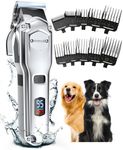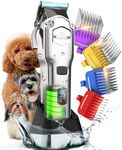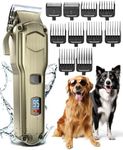Buying Guide for the Best Clippers For Dogs With Thick Coats
When choosing clippers for dogs with thick coats, it's important to consider the specific needs of your pet's fur type. Thick coats can be challenging to manage, so selecting the right clippers will make grooming easier and more efficient. Look for clippers that are powerful enough to handle dense fur without overheating or causing discomfort to your pet. Additionally, consider the comfort and ease of use for yourself, as grooming can be a time-consuming task. Understanding the key specifications will help you make an informed decision and ensure a smooth grooming experience for both you and your dog.Motor PowerMotor power in dog clippers refers to the strength and speed at which the blades move. This is crucial for cutting through thick coats efficiently. Clippers with higher motor power can handle dense fur without getting bogged down or overheating. Motors are generally categorized into pivot, rotary, and magnetic types. For thick coats, rotary motors are often preferred as they provide consistent power and can handle heavy-duty grooming. When choosing, consider how often you'll be grooming and the thickness of your dog's coat. If your dog has a very thick coat, opt for a clipper with a powerful motor to ensure smooth and effective grooming.
Blade TypeThe blade type determines how well the clippers can cut through different fur textures. For thick coats, it's important to have sharp, durable blades that can handle the density without pulling or snagging. Blades are typically made from stainless steel or ceramic. Ceramic blades stay cooler for longer, which can be beneficial for extended grooming sessions. Stainless steel blades are durable and often more affordable. Consider the maintenance required for each type; ceramic blades may need more careful handling. Choose a blade type that suits your grooming frequency and your dog's coat thickness.
Blade SizeBlade size affects the length of the cut and the precision of grooming. For thick coats, larger blade sizes can help remove more fur quickly, while smaller sizes offer more precision for detailed grooming. Blade sizes are usually numbered, with lower numbers indicating longer cuts and higher numbers for shorter cuts. If you're looking to maintain a longer coat, opt for a lower-numbered blade. For a shorter, more manageable cut, a higher-numbered blade may be more appropriate. Consider your dog's breed and the desired coat length when selecting the blade size.
Heat and Noise LevelsHeat and noise levels are important for the comfort of both the pet and the groomer. Clippers that generate excessive heat can cause discomfort or even burns to your pet, while loud noise can be stressful. Look for clippers that are designed to stay cool and operate quietly. Some models have features like cooling fans or vents to manage heat. Noise levels can vary, so if your dog is sensitive to sound, consider clippers that are specifically marketed as quiet. Balancing power with comfort is key, so choose clippers that offer a good compromise between performance and a pleasant grooming experience.
Corded vs. CordlessThe choice between corded and cordless clippers depends on your grooming setup and preferences. Corded clippers provide consistent power and are ideal for long grooming sessions, but they require access to an electrical outlet. Cordless clippers offer more flexibility and ease of movement, which can be beneficial if your dog is fidgety or if you need to groom in different locations. However, they rely on battery life, which may limit the duration of use. Consider how and where you plan to groom your dog. If you need mobility and convenience, cordless might be the way to go, but for uninterrupted power, corded clippers are a reliable choice.














